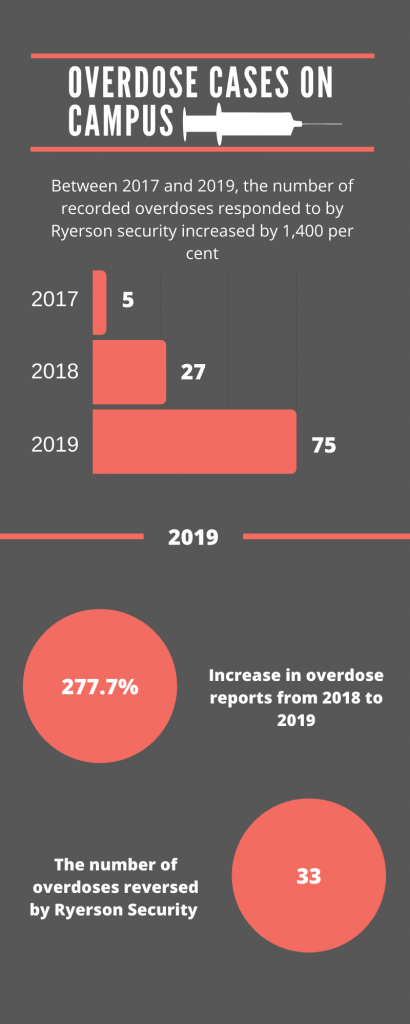Significant increase in overdose reports on campus attributed to better response capacity and inadequate services for drug users

Last year, Ryerson Security responded to 75 suspected opioid overdoses on campus — a large increase from 2018, when only 27 incidents were reported. Security personnel administered naloxone — a life-saving drug that reverses the effects of an overdose — in 33 instances during 2019. This represents a 412 per cent increase from 2018, when naloxone was administered only eight times.
The Ryersonian obtained records of all reported overdose incidents via a freedom of information request. The records span from late 2017 to the end of 2019 and include details such as the use of naloxone and EMS response.

Denise Campbell, executive director of community safety and security, attributed this increase in overdose reports and reversals to the fact that Ryerson security now carries naloxone and has “increased the coverage on campus in an effort to prevent overdoses.”
Ryerson was initially hesitant to equip security with naloxone, but personnel began to carry it in early 2018 in light of the opioid epidemic that is unfolding in the downtown core.
Alannah Fricker, president of the Ryerson chapter of the Canadian Students for Sensible Drug Policy and administrator to the Jack Layton Chair and the Toronto Harm Reduction Alliance, agreed that the increase is tied to policy as opposed to an increase in drug use.
“It’s not that people are flocking to campus to do drugs, it is that we are more equipped to handle overdoses,” she said.
Fricker said that another factor contributing to increased overdose reports and reversals on campus is the inadequacy of services available for drug users in Toronto. Fricker said that with fentanyl and other dangerous substances being found in the drug supply, more people are seeking out a safe place to use drugs.
For patrons of The Works — a public health office and supervised consumption service at Victoria and Dundas Streets — the high demand for services can result in long wait times. Fricker said that this can lead to dangerous alternatives like people seeking out quiet places nearby, such as bathrooms, to administer drugs.
In October, Ryerson University implemented new hours and access requirements for some buildings on campus as part of a pilot project. According to Ryerson Community Safety and Security, this change was made in an attempt to increase the safety of campus. Fricker said that while this may prevent people from overdosing in bathrooms on campus, it simply moves the problem to a different place instead of addressing it.
“Ryerson presents itself as a city builder and leader in this community, but we aren’t seeing that here.”
Fricker said that while mistakes have been made as Ryerson navigates its role in harm reduction, she is happy with much of the progress she has seen.
“Security cannot be monitoring every bathroom all the time and it is frankly a miracle that no one has died in our bathrooms yet,” she said.
Ryerson security meets monthly with staff from The Works and sits on a Ryerson board for addressing harm reduction activities in the community. Campbell said that the school’s “relationship [with The Works] has become increasingly important to us as we address a rise in the need for life-saving interventions due to overdose.”
Information on how to identify an overdose in progress and how to help can be found on the City of Toronto’s website.
Op-ed Editor and reporter. Send me your pitches at julie.mutis@ryerson.ca

